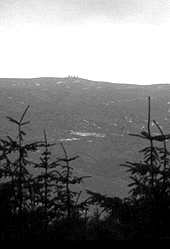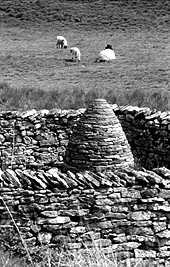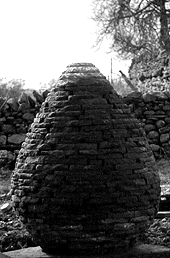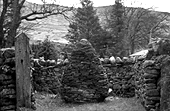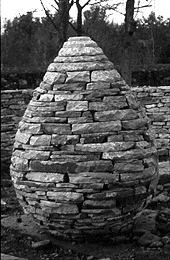| Sheepfolds to Visit | |
News | Education | Images | Accessibility | Search | Links |
|
|
'From 1981 until 1985 I lived at Brough in Cumbria. For some of that time I worked as a part-time gardener on the Helbeck Estate, just above Brough. From the walled garden on a clear day I could see across to Hartley Fell and the constructed piles of stones called the Nine Standards. Although not very large compared to the scale of the overall surrounding landscape it is extraordinary how the Standards dominate the valley below. They are a watchful presence on the skyline - slightly threatening yet at the same time guardian-like. I learnt much about the siting of sculpture from the Standards - not least, my own reluctance to place work directly on hilltops. It can be too obvious and at times arrogant - as if somehow the sculpture has claimed the hill. Only occasionally have I made work in such places. A few years earlier in 1980 I struggled for several days to make a stacked stone sphere. Climbing up to the Standards could have been the stimulus that provoked the ball to grow into a cone and become one of the most repeated and most travelled forms in my work. I know that I made my first cone at Brough and that one of the Standards is distinctly cone shaped. Like the cairns that define paths in the mountains and fells of Britain, the cones have become journey markers to my travels - leaving a trail. Some made in ice or branches remain as memories; others still stand in America, Australia, Sweden, Denmark, Scotland, France and England. There is however another journey that is for me possibly more important than travelling, which is the journey and exploration into the form itself. What may appear as repetition is in fact a deepening awareness of the richness and variation contained within the form. Sometimes differences can only be seen and understood through repetition. I learn something new with each new cone. When I stop learning I will stop making them. Each cone is a surprise. I don't remember making any cone that, upon completion, I did not feel an urge to pull it down and try again. I know, however, that the very irregularities that irritate me at the time of making will become those qualities that I like most about the sculpture. There are parallels with growth. Trees of the same species that grow in the same place, but produce enormous variation in their growth pattern. A tree grows with perfection as its intention but never achieves it - responding to the space into which it grows. 'The cones are made more by feel than calculation, especially those constructed at night. The resulting irregularities give energy to form and help it fit into the place. They are made with the same shape in mind, but the response to each stone, place and time produces enormous variation. Repeating this work makes me more aware of the differences. I am fascinated by the way a cone grows, stone upon stone, layer by layer - as a tree does, ring upon ring. By making slight changes in the placing of each stone, the shape can be brought out or taken in, made elegant or squat, full or empty. I enjoy the unpredictability of working by eye and hand. Tools and machinery are used for the larger, more permanent sculptures, but for the most part my hands are the best tools I have. I need direct contact between hand and earth. There is enormous freedom in going empty handed to a place and discovering there the material and the means to work with it. Each time I try to achieve a perfect cone but somehow always lose control in the making. Cones dictate their own shape and I resist making 'corrections' which might interrupt the flow of form. lrregularities must be worked through slowly to avoid harsh or abrupt changes. I must think beyond the detail of individual stones to an overall idea of the form. The day I make a perfect cone will possibly be the last time I make one. The cones are built solid for both practical and aesthetic reasons. The form is an expression of the fullness, vigour, heavy ripeness and power of nature generated from a centre deep inside - the seed becoming a tree and the unfolding of a flower. This feeling of endless layers of growth and internal depth would be lost if the cone were hollow. A concentration of energy is achieved when materials are drawn tightly together. It is this underlying energy that truly binds each piece to the next.' (4) The Nine Pinfolds * is an opportunity for me to take the cone back to its origin and to place it in counterpoint and dialogue with the Nine Standards. Where the Standards are dramatic monuments of the high ground mine will be monuments for the valley and village life. They sit within the enclosure of pinfolds, the walls of which take on a role similar to that of a protective outer shell of a seed. I like the idea of enfolding the cone within a walled enclosure which is itself enfolded by a village. The Nine Standards and the Pinfold Cones share a common purpose as guardians and I will do all that I can as an artist and maker to give the cones life, strength and energy that will bring to their respective villages good fortune. The form is full and ripe - an optimistic expression of the power of growth and that even out of stone comes life. They are strong yet the form appears precarious - not unlike the nature of growth itself.' References
|
|
|
© 2002 Copyright
Information
|
.
